Product Description
|
Process: |
CNC Machining, turning,milling, lathe machining, boring, grinding, drilling,broaching, stamping,etc… |
|
Surface treatment: |
Clear/color anodized; Hard anodized; Powder-coating;Sand-blasting; Painting; |
|
Nickel plating; Chrome plating; Zinc plating; Silver/gold plating; |
|
|
Black oxide coating, Polishing etc… |
|
|
Gerenal Tolerance:(+/-mm) |
Gear grade :7Gread (ISO) |
|
Run Out:0.005mm |
|
|
Roundness:0.001mm |
|
|
ID/OD Grinding: 0.002 |
|
|
Roughness : Ra 0.05 Rz 0.2 |
|
|
Certification: |
IATF 16949, ISO140001 |
|
Experience: |
16 years of machining products |
|
Packaging : |
Standard: carton with plastic bag protecting |
|
For large quantity: pallet or wooden box as required |
|
|
Lead time : |
In general:30-60days |
|
Term of Payment: |
T/T, L/C |
|
Minimum Order: |
Comply with customer’s demand |
|
Delivery way: |
Express(DHL,Fedex, UPS,TNT,EMS), By Sea, By air, or as required |
ZheZheJiang nlead Precision Co., Ltd. which focuses on CNC machining, including milling, turning, auto-lathe turning,holing,grinding, heat treatment from raw materials of bars, tube, extruded profiles, blanks of cold forging & hot forging, aluminum die casting.
We provide one-stop service, from professional design analysis, to free quote, fast prototype, IATF16949 & ISO14001 standard manufacturing, to safe shipping and great after-sales services.During 16 years, we have win lots of trust in the global market, most of them come from North America and Europe.
Now you may have steady customers, and hope you can keep us in the archives to get more market news.
Sunlead produce all kinds of machining parts according to customer’s drawing, we can produces stainless steel Turned parts,carbon steel Turned parts, aluminum turned parts,brass & copper turned parts.
Please feel free to send inquiry to us, and our professional sales manager will get back to you ASAP!
FAQ:
Q1: How can I get the samples?
A: If you need some samples to test, you should pay for the transportation freight of samples and our samples cost.
Q2: Can we have our marking,Logo or company name to be printed on your products or package?
A: Sure. Your marking,logo,or company name can be put on your products by Laser machine
Q3: How to order?
A: Please send us your purchase order by Email, or you can ask us to send you a Performa invoice for your order. We need to know the following information for your order.
1) Product information-Quantity, Specification ( Size, Material, Technological and Packing requirements etc.)
2) Delivery time required
3) Shipping information-Company name, Street address, Phone&Fax number, Destination sea port.
4) Forwarder’s contact details if there’s any in China.
Q4: When can you get the price?
We usually quote within 48 hours after we get your inquiry. If you are very urgent to get the price, please call us or tell us in your email so that we will regard your inquiry priority. Kindly note that if your inquiry is with more details then the price we quote will be more accurate.
Q5: How can you get a sample to check our quality?
After price confirmation, you can require for samples to check our quality.
Q6: What kind of files do we accept for drawing?
A: PDF, CAD,STP,STEP
Q7: What about the lead time for mass production?
Honestly, it depends on the order quantity and the season you place the order. Generally speaking,it would need about 30-60days to finish the sample.
Q8: What is our terms of delivery?
We accept EXW, FOB, CFR, CIF, DDU, DDP, etc. You can choose the 1 which is the most convenient or cost effective for you.
| Application: | Fastener, Auto and Motorcycle Accessory, Hardware Tool, Machinery Accessory |
|---|---|
| Standard: | GB, EN, China GB Code |
| Surface Treatment: | as Requiried |
| Production Type: | Mass Production |
| Machining Method: | CNC Machining |
| Material: | Steel, Brass, Alloy, Copper, Aluminum, Iron |
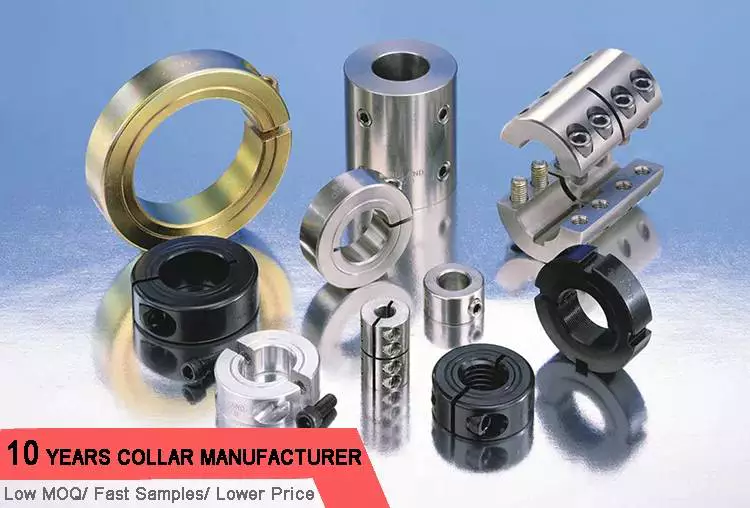
Common Uses for the Shaft Collar
The shaft collar is a relatively simple machine component, but one of the most important in many power transmission applications. It is most often used in gearboxes and motors, where it serves as a locating component, bearing face, and mechanical stop. Its simple design allows for easy installation and makes it ideal for a range of applications. Listed below are some of the most common uses for the shaft collar. Learn more about this important machine component.
Single split
Two-piece shaft collars are an excellent option for applications where a single piece collar is not practical. They provide the same benefits as one-piece collars, but with more convenience when installing. The two-piece collar has a clamp style, which allows the collar to be adjusted with a hand tool. They are suitable for light-duty applications and come in a variety of diameters. In addition to shaft diameters, collars are available with different threaded bore sizes. Shaft diameters are usually measured in mm. They can be easily installed and disassembled by removing the cap screws from each side.
Single split shaft collars come with a machine screw that tightens the clamp around the shaft. This ensures a tight, secure fit and better holding power than solid collars. They are easy to install, remove, and adjust, and work on virtually all types of shafts. The machine screw helps to prevent the collar from ripping the shaft.
Shaft collars come in a variety of materials. Typical materials include stainless steel, alloyed steel, and nylon. They are also available in custom sizes. If you want a specific size, be sure to specify that when ordering. These collars are made of quality materials, and they will hold up to the most rigorous applications.
Heavy duty shaft collars are manufactured from higher-grade materials than standard collars. They have a larger outer diameter, wider flange, and a larger screw for increased holding power. These collars are typically used in short-term, rigid coupling applications, and they are available in one-piece and two-piece clamp styles. These collars are typically made from 1215 lead-free steel or 303 stainless steel. Some of them can be finished with an anodized finish.
Mountable shaft collars are used to mount sensors, fixtures, and other assemblies. There are three different styles of mountable shaft collars: flange collars, flat collars, and quick-release collars. The material used for shaft collars can be 1215 lead-free steel with a black oxide finish, high-strength aluminum, and 303 stainless steel.
Solid
A solid shaft collar is a shaft coupling that is used to connect two shafts. They can be made of a variety of materials, including steel, zinc plated, and stainless steel. In addition, they come with various finishing options, including a zinc plated or black oxide finish. In addition, they can be made to fit a variety of shaft sizes and types.
Shaft collars are a simple, yet essential part of machine design. They can be found in virtually any piece of machinery. They can serve a variety of functions, including holding bearings on shafts, positioning components within motor assemblies, and acting as mechanical stops. While they can serve a variety of functions, they are most commonly used as bearing faces, mechanical stops, and locating components. They are also easy to install and tighten, making them a popular choice for a variety of different applications.
Solid shaft collars are available in two types: one-piece and two-piece. The two-piece collars are generally more rigid, offering better clamping force. However, they require more seating torque than the one-piece clamp collar. This is because there are more screws to tighten the two-piece collar than the single-piece collar.
One type of solid shaft collar is the set screw collar. Its holding power comes from the set screw, which is tightened onto the shaft. Ideally, the set screw should impinge on the shaft, and bite into it. The screw should be made of a softer material, as a harder material would reduce its holding power. However, the set screw collar can be adjusted by milling small flats into the shaft at the locations of the set screw.
A solid shaft collar is a simple machine component used in various power transmission applications. The most common places where it is used include motors, gearboxes, and bearings. Their simple design makes it easy to install and maintain. Unlike early versions, however, which were primarily made of square-headed set screws, modern shaft collars feature recessed set screws.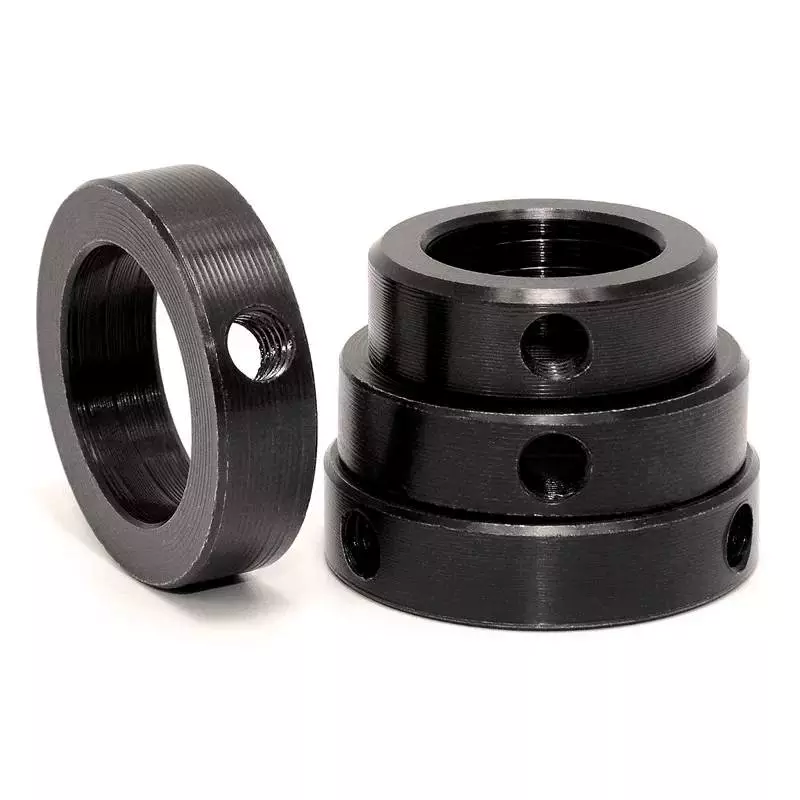
lamping-style
A Clamping-style shaft collar is an essential component of a gearbox or motor. Its high holding power allows it to hold components securely in place and ensure proper power transmission. These collars are also commonly used as spacers or to limit the movement of shafts during reciprocating motion.
These collars come in a variety of styles, including the double-split and semi-split varieties. They are ideal for repetitive positioning and are available in steel and stainless steel. They also feature a quick release element. And the index lever makes them easy to adjust or repair.
There are several different styles of shaft collars, including the Clamping-style shaft collar. The Clamping-style collar is one of the most commonly used in industrial settings. Its clamp is attached to the shaft by screws and has a hinge on one side. This feature eliminates the risk of the screws becoming dislodged while operating the machine.
Clamping-style shaft collars are generally made of steel or stainless steel. They can be made of aluminium, but this material has lower holding power. Stainless steel collars are a good choice for cleanroom environments because they do not outgas. They also require less maintenance. If you’re uncertain which style to choose, consult with a specialist in your field.
Clamping-style shaft collars are commonly used on industrial machinery and are an important part of gearbox maintenance. If you’re planning to install one, make sure you measure it carefully before you install it. If you don’t, you may damage the shaft or endcap. And while you’re at it, be sure to check for any kinks before you use it.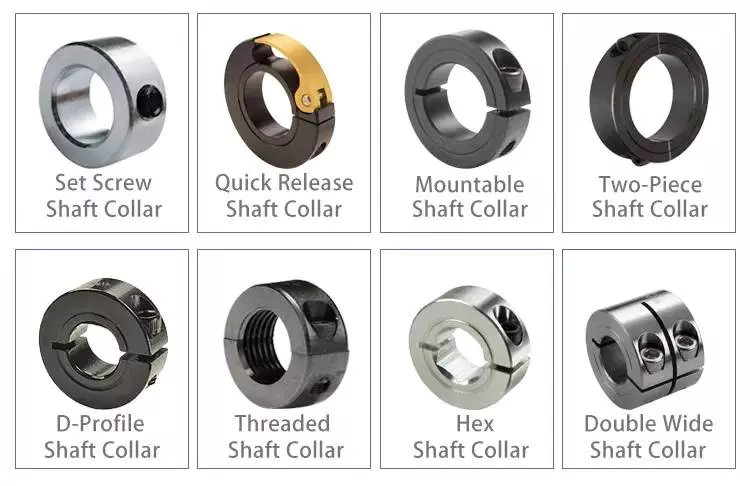
Set screw
Set screw shaft collars are the most cost-effective type of shaft collar. Available in bore sizes ranging from 3/16″ to 4″, they offer increased holding power and torque capacity. Additionally, they come with a keyway in case the shafts are keyed. Commercially produced shaft collars are non-magnetic and made of 303 stainless steel. They also come with one set screw per collar.
Shaft collars can be made of aluminum, steel, or a combination of steel. They serve multiple purposes including mechanical stops and stroke limiters, and can be adjusted for the correct fit. They are easy to install and remove, and they provide high clamping power. Custom designs are also available. They can be made of different materials to suit your specific needs.
Set screw for shaft collars are commonly used in transmission and machinery applications. Set screw shaft collars can be adjusted using a screw driver. When tightened, the set screw bites into the shaft material and holds it in place. When used properly, they can reduce the amount of torque required to hold components in place.
Shaft collars come in a variety of sizes. In general, shaft collars can range from 5/64″ to one inch in diameter. In addition, you can choose between metric and inch-sized shaft collars. When choosing a shaft collar, it is important to consider the size and bore diameter of the shaft.

editor by CX 2023-05-26
China Best Sales Bulldozer Undercarriage Parts Df Roller GRP W/Collars Catd4h 1248240 Cr6151 brass shaft collar
Product Description
Excavator Dozer Spare Parts Track Idler Roller PC100, PC120, PC400, Sk330, Sk450
spare part
undercarriage part
Track Idler
Front Idler
Rear Idler
Idler Roller
Idler Wheel
Product Details
| Details Of Idler | |
| Product Describiton: | Idler/Front Idler/Track Idler |
| Material: | |
| Body | 40Mn/SCMn3A |
| Bracketing: | QT450-10 |
| Cover: | 42SiMn |
| Shaft: | 45# |
| Floating Seal: | 15CrNiMo3 |
| O-Ring: | Rubber |
| Double Metal Set: | CuPd10Sn10 |
| Inside Hex Bolt: | JB/T1000-1977 |
| Lubricated Oil: | SAE85 |
| Heat Treatment and Hardness | |
| Body | HRC52-58 Hardness:>3.6 |
| Shaft | HRC52-58 Hardness:>2.6 |
| Finish: | Smooth |
| Color: | Black/Yellow/Grey/Red/Other |
| HS Code: | 8431499900 |
| Place of Original: | China(Mianland) |
| Package: | Standard Export Fumigated Wooden pallet |
Spare parts Track Idler PC100 ,PC120 ,PC400,SK330.SK450 for Excavators and Bulldozers
Feature:
1). Safe packing to protect the goods, such as wooden box,by tray.
2). Small quantity can accept.Sample order also accept.
Advantages:
1). Quick delivery and competitive price.
2). The larger quantity you order, the better price and faster delivery we can supply.
Spare parts Track Idler PC100 ,PC120 ,PC400,SK330.SK450 for Excavators and Bulldozers
Packing:standard export fumigated wooden pallet
Our Related Products
After-Sales service
1)Offer us picture of using situation,goods,using details,then compensation after everything is finished within 3 working days.
2)Any claim due to the quality of products,the compensation is not more than the value of the products that have quality problem.
| Warranty: | 1 Year |
|---|---|
| Type: | Excavator & Bulldozer Spare Parts |
| Application: | Excavator & Bulldozer Spare Parts |
| Certification: | CE, ISO9001: 2000 |
| Condition: | New |
| Product Name: | Idler or Idler Wheel |
| Samples: |
US$ 500/Piece
1 Piece(Min.Order) | |
|---|
| Customization: |
Available
| Customized Request |
|---|
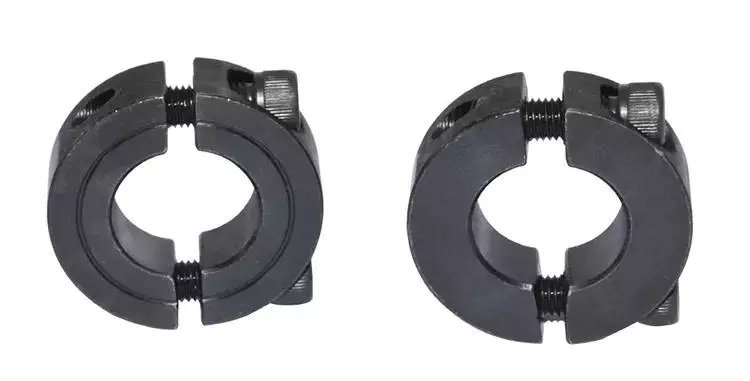
Choosing a Shaft Collar
The shaft collar is a simple machine component used in a variety of power transmission applications. They are most often found on gearboxes and motors. Their simple design makes them an easy component to install and remove. Among other uses, shaft collars are used as bearing faces, mechanical stops, and locating components.
Clamp-style shaft collars
Clamp-style shaft collars fix many of the problems associated with set-screw collars. Available in two-piece and one-piece designs, these collars compress the shaft and lock into place. This allows for a uniform distribution of force on the shaft. Clamp-style shaft collars provide more holding power than set-screw collars, but they work best under consistent pressure. Clamp-style shaft collars also work better against negative forces, as they have a separate, un-tightened side.
Clamp-style shaft collars feature mounting holes in the outer diameter. Like clamp-style collars, mountable shaft collars can be installed on adjacent assemblies, but the mounting method does not affect holding power. Mountable shaft collars are commonly used in mounting sensor brackets. They may have rounded or flat outer diameters to accommodate the mounting process. Mountable shaft collars may also have tapped or flat holes to facilitate installation.
Quick-clamp shaft collars have the same functionality as clamp-style collars, but feature a removable lever. They are typically quick-to-install and do not mar the shaft. Quick-clamping collars are especially beneficial in applications that require light-duty torque. They also make for quick and easy adjustments.
Heavy-duty shaft collars feature larger outer diameters, a wider face, and a larger screw. These collars are ideally suited for d-shafting and can offer greater holding power than set-screw collars. These collars are typically manufactured from high-strength 2024 aluminum.
Clamp-style shaft collars can be used in many different applications. They can be used for a variety of applications, including bearings, and are especially suited for rotary machines. However, there are some drawbacks. While they may not be as flexible as set-screw collars, they can still perform well under constant loads. One drawback is that they tend to loosen under shocks and reduce the holding power of clamping hardware.
Another advantage of clamp-style shaft collars is that they do not mar the shaft and allow for easy positioning adjustments. Furthermore, they are easier to install and offer greater holding power than set-screw collars. These collars are made from high-quality materials with tight tolerances and are available in different bore sizes.
Clamp-style shaft collars are the most common type of shaft collars. They can be two-piece or one-piece. Among these, two-piece collars are the most convenient option. One-piece collars are hard to move, and two-piece collars have a hinge on one side and a clamp-style collar on the other side.
The materials used in Clamp-style shaft collars play a crucial role in their overall performance. They should be strong, corrosion-resistant, and have good holding power. They should also be able to withstand high temperatures. The most common materials used for shaft collars are steel and aluminum. Some types are made from stainless steel, while others are made from engineered plastic.
Clamp-style shaft collars can come in two pieces or single-piece designs. The smaller one-piece collars usually have a back-cut opposite the clamp cut, which reduces the cross-sectional area at the hinge point. This reduces the amount of force required to clamp the collar, which makes it easier to use stronger screws.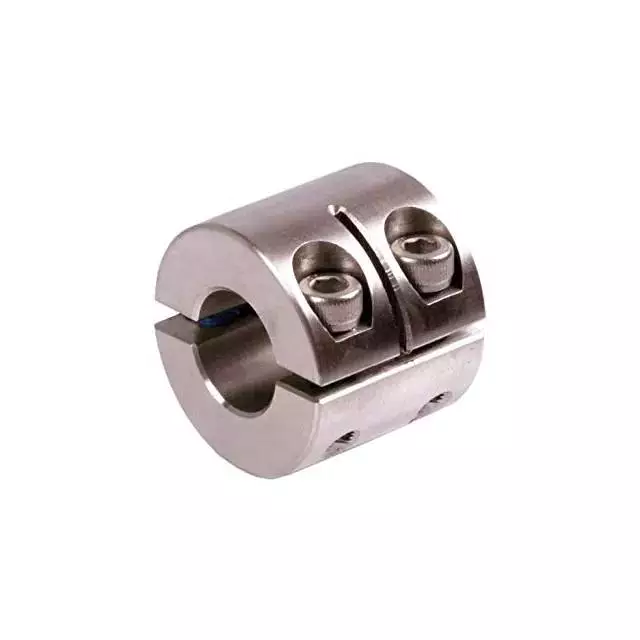
Aluminum, carbon steel, and stainless steel shaft collars
When choosing a shaft collar, you should consider the material it is made of. You can purchase collars made of carbon steel, aluminum, or stainless steel. Each of these materials has its benefits and disadvantages. Steel is more durable than aluminum and tends to provide better holding power. Aluminum, on the other hand, is lighter and has a favorable strength-to-weight ratio. The material you choose should depend on your specific needs, such as corrosion resistance or weight.
Mountable shaft collars are used to mount sensors, fixtures, and other assemblies. These collars are available with outer diameter holes, flats, or quick-release designs. The material used to make these collars varies, with standard models made of 1215 lead-free steel and 2024 aluminum.
When choosing shaft collars, take into account the material and surface treatment. Different materials offer different properties, which will determine the performance of the collar. In addition to material, each shaft collar comes with a different holding power. Holding power is a key factor in choosing a shaft collar because it determines the amount of load it can withstand without slipping. The holding power depends on the screw size, the bore size, and the bulk of the collar.
Aluminum, carbon steel, and stainless steel shaft-collars can come in various styles. CZPT, for example, offers standard shaft collars in hex and d-bore profiles. Hex collars provide extra holding power and are better than set screws. Additionally, they do not mar the shaft and provide a better grip.
Another type of shaft collar is the quick-clamp shaft collar. These features allow users to install and remove them with ease. The quick-clamp collar has a handle that allows the user to quickly adjust it. While these shaft collars are designed for light duty applications, they are not recommended for heavy-duty or high-RPM applications.
Shaft collars are simple yet versatile components. They are used for various applications, including mechanical stops, stroke limiters, and retainers. They can also be used to align and space other components. Shaft collars are widely used in gearbox assemblies, flagpoles, and medical instruments, among others.
Two-piece shaft collars offer the same benefits of one-piece shaft collars, but offer additional convenience and versatility. They are easier to install and disassemble, reducing installation and labor costs. They also offer superior holding power. They also feature a threaded bore that acts as a positive mechanical stop when the shaft is rotated.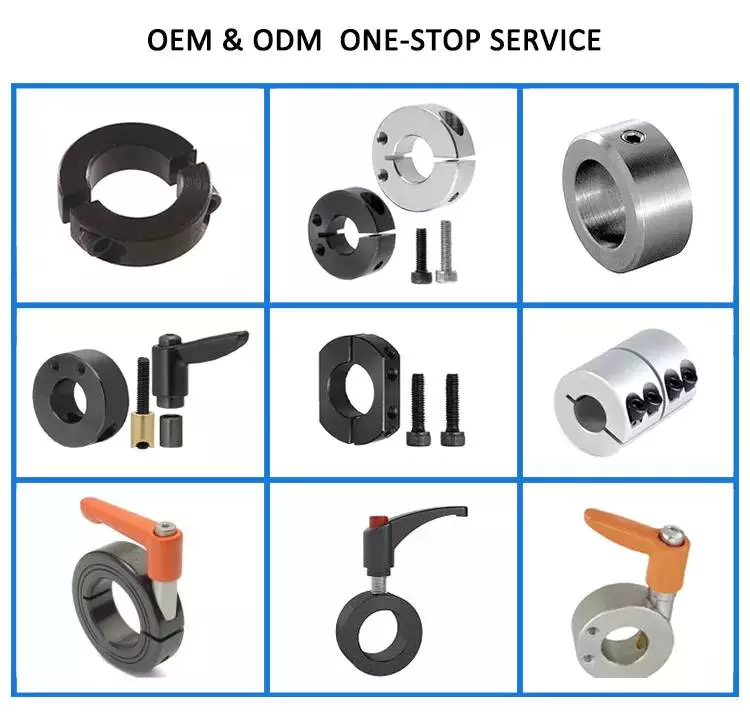
Over-torqueing shaft collars
Shaft collars are often used to secure components on shafts or other surfaces. They also provide an easy way to adjust the positioning of motor assembly components. Many different types of shaft collars are available to meet the specific needs of different applications. These include round, hexagonal, square, and D-bore collars.
The design of shaft collars must account for the load they will support. Some collars are made of metals, while others are made of plastic or composite materials. Typically, shaft collars are made of steel, but can also be made from aluminum or alloyed steel. Some are coated with zinc.
Shaft collars are available in one-piece and two-piece designs. Single-piece collars are designed to fit securely around a shaft, while double-piece collars allow for greater clamping force. These collars can be assembled anywhere along the shaft and can be installed between two pieces. They are available in different bore configurations and can be customized to meet your specific application.
Clamp style collars are easy to install and disassemble, and have a larger holding force than one-piece collars. These collars are also more shock-load resistant. They also don’t mar shaft surfaces, unlike setscrews. They can also be easily adjusted without damaging the shaft. Another style of collar is the quick-clamping style. This type of collar doesn’t mar the shaft, and is easily installed and removed without tools. These are best for light-duty applications.
When choosing a shaft collar, you should consider the tolerance of the shaft. It is important to select a shaft with a tight tolerance. The shaft’s hardness should not be greater than Rockwell C35. A wide tolerance will affect the holding power of the collar. If the shaft is undersized, you may need to use a screwdrive to slide the collar on the shaft.
Shaft collars are a versatile component with many different applications. They can secure industrial railings or serve as positioning devices in medical equipment. They are also widely used in automation machinery. They are used to protect cylinders and actuators and to ensure alignment between components. For this reason, they are very versatile and adaptable.
Clamp-style collars work well under constant loads, but they may need assistance during impact loads. Shock loads can be difficult to avoid, especially if the mass is small. Clamp-style collars with an undercut in the shaft help to resist the impact of shock. Moreover, they offer positive stops in both axial directions.
Clamp-style shaft collars are a good alternative for set-screw collars. They are easy to install and prevent shaft damage. They also come with an added advantage of being easy to adjust. Clamp-style shaft collars have double the holding power of set-screw collars.
In addition to holding components, shaft collars can also function as spacers and limit shaft movement. They are essential for many applications. They are commonly used in motors and gearboxes to ensure correct positioning for power transmission. They are also used to control shaft movement in reciprocating applications.

editor by CX 2023-05-15
China Power Transmission Shaft Coupling Roller Shaft Coupling diy shaft collar
Merchandise Description
Couplings:
1. The couplings provide a variety of hub and component assortment to fulfill various needs.
two. They can take in shock and cater for incidental misalignment and damp out little amplitude vibrations.
3. NBR, Urethane, Hytrel aspects.
four. Personalized requirement is offered.
Main Merchandise:
1. Timing Belt Pulley (Synchronous Pulley), Timing Bar, Clamping Plate
two. Forging, Casting, Stampling Part
three. V Belt Pulley and Taper Lock Bush Sprocket, Idler and Plate WheelSpur Gear, Bevel Gear, Rack
4. Shaft Locking Device: could be alternative for Ringfeder, Sati, Chiaravalli, Tollok, etc.
five. Shaft Coupling: including Miniature couplings, Curved tooth coupling, Chain coupling, HRC coupling,
Normex coupling, Type coupling, GE Coupling, torque limiter, Universal Joint
6. Shaft Collars: including Setscrew Type, Single Split and Double Splits
7. Equipment & Rack: Spur equipment/rack, bevel gear, helical equipment/rack.
eight. Other customized Machining Parts according to drawings (OEM) Forging, Casting, Stamping Parts.
PACKING
| Packaging | |
| Packing
|
We use regular export wood circumstance, carton and pallet, but we can also pack it as per your unique demands. |
OUR Organization
ZheJiang Mighty Machinery Co., Ltd. specializes in giving ideal provider and the most competitive price for our customer.
After in excess of 10 years’ challenging perform, MIGHTY’s company has developed swiftly and grow to be an essential partner for oversea consumers in the industrial discipline and become a holding company for 3 manufacturing factories.
MIGHTY’s products have acquired status of domestic and oversea customers with using gain of engineering, management, high quality and quite competitive price.
Your gratification is the greatest motivation for our perform, pick us to get large quality items and best support.
OUR Manufacturing facility
FAQ
Q: Are you trading organization or manufacturer ?
A: We are manufacturing unit.
Q: How lengthy is your shipping and delivery time?
A: Typically it is 5-ten times if the items are in stock. or it is 15-twenty days if the products are not in stock, it is according to amount.
Q: Do you supply samples ? is it totally free or extra ?
A: Of course, we could offer you the sample for cost-free charge but do not spend the price of freight.
Q: What is your conditions of payment ?
A: Payment=1000USD, thirty% T/T in advance ,balance before shippment.
We warmly welcome pals from domestic and overseas appear to us for business negotiation and cooperation for mutual reward.To supply consumers excellent good quality goods with good price and punctual shipping and delivery time is our duty.
| Standard Or Nonstandard: | Standard |
|---|---|
| Shaft Hole: | 19-32 |
| Torque: | >80N.M |
| Bore Diameter: | 19mm |
| Speed: | 4000r/M |
| Structure: | Flexible |
###
| Samples: |
US$ 1/Piece
1 Piece(Min.Order) |
|---|
###
| Customization: |
Available
|
|---|
###
| Packaging | |
| Packing
|
We use standard export wooden case, carton and pallet, but we can also pack it as per your special requirements. |
| Standard Or Nonstandard: | Standard |
|---|---|
| Shaft Hole: | 19-32 |
| Torque: | >80N.M |
| Bore Diameter: | 19mm |
| Speed: | 4000r/M |
| Structure: | Flexible |
###
| Samples: |
US$ 1/Piece
1 Piece(Min.Order) |
|---|
###
| Customization: |
Available
|
|---|
###
| Packaging | |
| Packing
|
We use standard export wooden case, carton and pallet, but we can also pack it as per your special requirements. |
Different Types of Shaft Collars and How to Choose the Right One For Your Needs
A shaft collar is a simple machine component, but its role is crucial in a variety of power transmission applications. It is most commonly found in gearboxes and motors. Its simple design makes it a relatively easy component to install. In addition to being useful for bearing faces, shaft collars are also used as mechanical stops.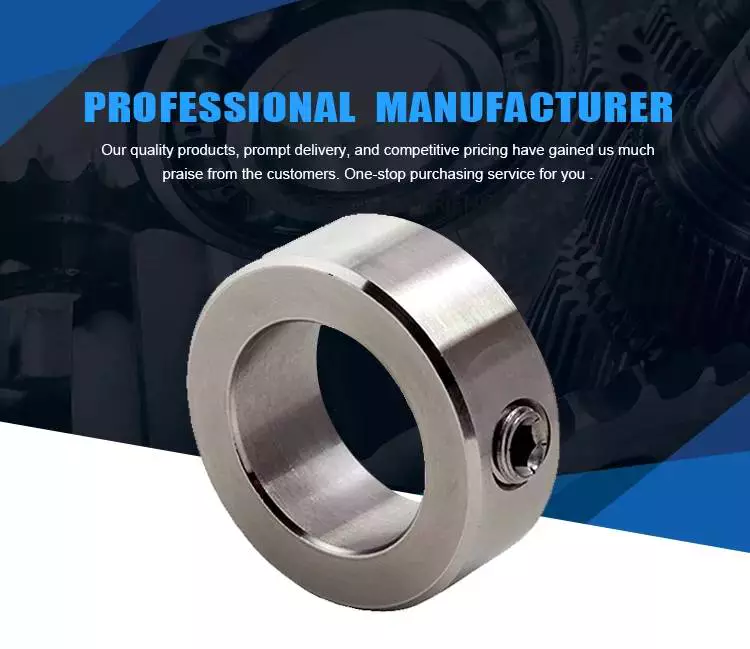
Single split shaft collars
Single split shaft collars are a common design choice for industrial applications. They provide easy installation and disassembly, reducing downtime and labor. Unlike traditional collars, they use full seating torque of set screws, resulting in even distribution of forces along the shaft circumference. In addition, they provide stronger holding power.
Single split shaft collars are available in a variety of sizes and materials. They are typically made of stainless steel, alloyed steel, or nylon. They are available with a black oxide finish or a smooth finish. In addition, they can be manufactured to custom sizes. The benefits of shaft collars manufactured by Power Rite are the high quality of their materials and the close tolerances of their manufacturing process.
Single split shaft collars are available in D-bore or hex bore configurations. They are designed to fit shafts with diameters from 1/4″ to 6″. Some of these types also have a proprietary black oxide finish. Single split shaft collars can be manufactured with a range of materials, including 303 stainless steel and 1215 lead-free steel. They can also be made with engineered plastic.
Single split shaft collars are an excellent choice for applications where accurate positioning is essential. These collars can be easily installed and removed without removing any of the shaft components. They feature double grub screws to help tighten the clamp around the shaft. This feature makes installation and removal easier and reduces downtime.
Single split shaft collars are also available in a lightweight style for applications where space is an issue. While these collars are ideal for light-duty applications, they are not ideal for heavy-duty environments. Single split shaft collars are generally made of a softer material, such as steel. They have high torque capacities and hold securely around a shaft. However, their high holding power and low friction means they can damage a shaft or cause indentations that make repositioning the shaft difficult.
Clamp-style shaft collars are another option for tougher installations. This type offers more clamping power than a one-piece shaft collar. They come in either a one-piece or two-piece design, and can be installed by hand.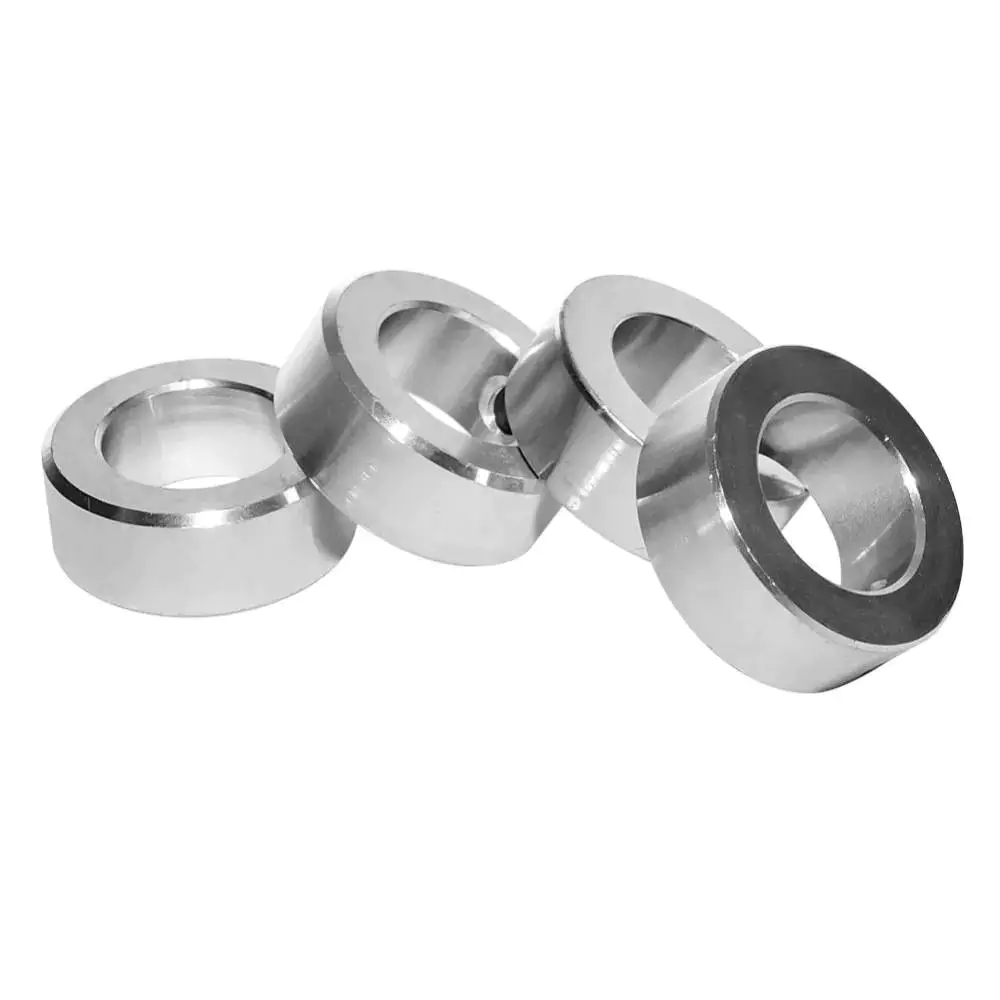
Set screw collars
Set screw collars are used to secure shafts. They are available in a variety of sizes and materials. Available options include hex socket, cup point, and 3A thread screws. They are suitable for a variety of industries, including food, wood, and chemical. A distributor of set screw collars can custom-design them to meet the specifications of a given application.
There are many different types of shaft collars, which include socket set screw collars, 2-hole set screw collars, and metric and stainless steel collars. In addition to these, you can also find corrosion-resistant set screw collars with a black oxide finish. These collars are ideal for industrial and commercial applications and are RoHS compliant.
Set screw collars are the most cost-effective option for shaft collars. They also offer lightweight options for applications where space is at a premium. Additionally, they can be equipped with a second screw positioned at 90 degrees to provide additional load capacity. They also come with a keyway to accommodate keyed shafts. These collars provide a reliable solution for securing shafts in a variety of applications.
Compared to set screw collars, clamp-style collars are easier to install and have greater holding power. They are available in one and two-piece versions. Clamp style collars are designed to lock onto a shaft while not damaging it. In addition, they are easily removed and reinstalled. They can be used in a variety of settings, including in guiding systems and bombsights.
Set screw shaft collars are an excellent choice for applications where precision is important. They prevent shafts from moving and hold power transmission components in place. The set screw collar is set in place with a grub screw or set screw. The screw driver can adjust the set screw to achieve the desired position.
Quick-clamp shaft collars
Quick-clamp shaft collars are a simple yet effective way to secure shafts. These collars have an eccentric lever that generates a locking force on the shaft. They are easy to install and remove and are manufactured with an aluminum design. In addition, these collars have a low mass inertia value. They are available in both one-piece and two-piece styles. Both styles have outer diameter flats for mounting other components.
The Quick-clamp shaft collars are resilient and feature a flush handle. They are easy to install and adjust, eliminating the need for tools and reducing production downtime. Another feature of these collars is that they have a high-strength tension adjustment screw that ensures compatibility with a wider range of shaft tolerances. These collars also have an axial holding power adjustment screw.
CZPT manufactures two types of quick-clamp shaft collars. One type has a cam lever that sits flush with the outside diameter and is finger-actuated. The other type is a clamp-style collar with a tension-adjustment screw. This design is better suited to low-rpm applications, or for frequent changeovers.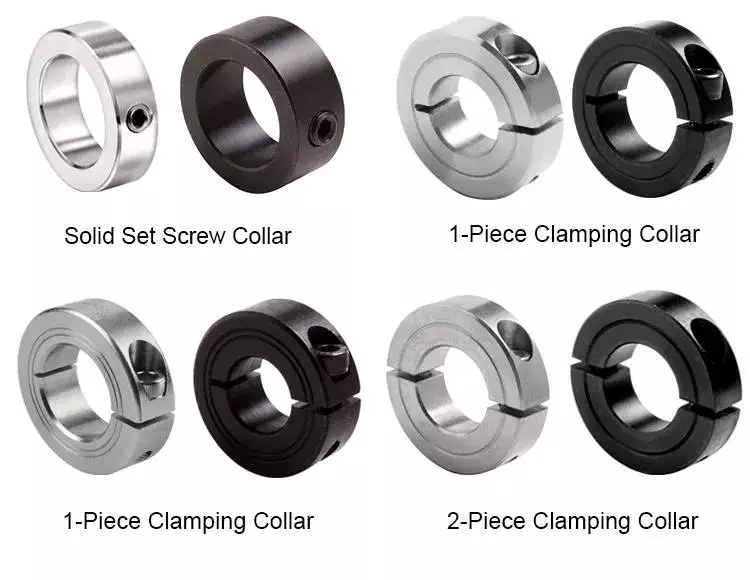
Choosing the right shaft collar for your application
Shaft collars play a key role in many industrial applications, and choosing the correct one is critical. They need to be designed properly and have the appropriate performance characteristics to ensure safe and effective operation. In this article, we will look at the different types of shaft collars and how to choose the right one for your needs. Typically, shaft collars are made from steel or aluminum, coated with zinc or another corrosion resistant material. But they can also be made from non-metallic materials.
Shaft collars come in a variety of shapes and materials, and the right one for your application will depend on these features. The key factors to consider are the material, holding power, and surface treatment, and their alignment with your application specifications. The shaft collars that fit your application best are often highly customizable, so it is important to determine the exact specifications for your application.
Shaft collars are simple and versatile components that are used to secure bearings on a shaft. They also serve as mechanical stops and can help to align and space other components. Shaft collars are widely used in gearbox assemblies, flagpoles, medical instruments, and other applications. They are available in a wide variety of styles, and can be used for nearly any application.
The type of shaft collar you choose will depend on the application and the type of machine. A heavier duty shaft collar will provide better vibration and shock resistance. These collars are typically designed for off-road or mining applications, and can be made of heavy-duty steel. They also provide more holding power, as double-wide shaft collars can provide an additional 25% of holding power.
When choosing a shaft collar, it’s important to consider the application and the required level of maintenance. Some assemblies will only need minor adjustments, while others require frequent disassembly. A two-piece shaft collar is a better option for assemblies that will have to be removed often.

editor by czh 2023-01-27